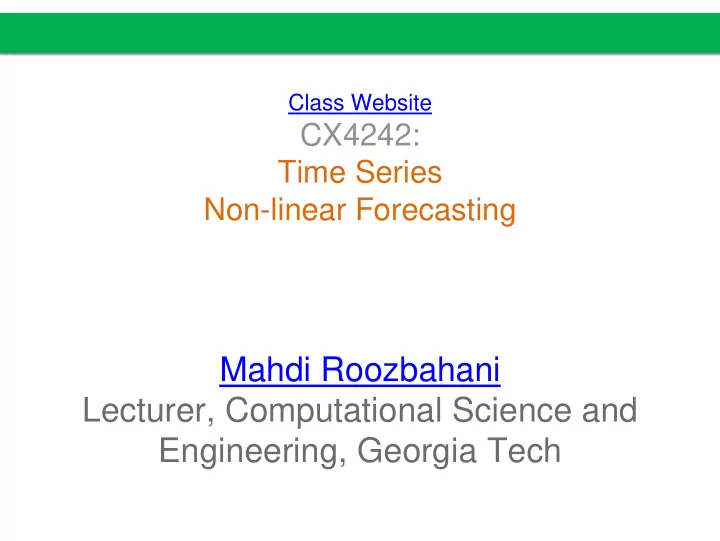

Class Website CX4242: Time Series Non-linear Forecasting Mahdi Roozbahani Lecturer, Computational Science and Engineering, Georgia Tech
Chaos & non-linear forecasting
Reference: [ Deepay Chakrabarti and Christos Faloutsos F4: Large-Scale Automated Forecasting using Fractals CIKM 2002, Washington DC, Nov. 2002.]
Detailed Outline • Non-linear forecasting – Problem – Idea – How-to – Experiments – Conclusions
Recall: Problem #1 Value Time Given a time series {x t }, predict its future course, that is, x t+1 , x t+2 , ...
x(t) Datasets time Logistic Parabola: x t = ax t-1 (1-x t-1 ) + noise Models population of flies [R. May/1976] Lag-plot ARIMA: fails
How to forecast? • ARIMA - but: linearity assumption Lag-plot ARIMA: fails
How to forecast? • ARIMA - but: linearity assumption • ANSWER: ‘Delayed Coordinate Embedding’ = Lag Plots [Sauer92] ~ nearest-neighbor search, for past incidents
General Intuition (Lag Plot) Lag = 1, x t k = 4 NN Interpolate these… To get the final prediction x t-1 4-NN New Point
Questions: • Q1: How to choose lag L ? • Q2: How to choose k (the # of NN)? • Q3: How to interpolate? • Q4: why should this work at all?
Q1: Choosing lag L • Manually (16, in award winning system by [Sauer94])
Q2: Choosing number of neighbors k • Manually (typically ~ 1-10)
Q3: How to interpolate? How do we interpolate between the k nearest neighbors? A3.1: Average A3.2: Weighted average (weights drop with distance - how?)
Q3: How to interpolate? A3.3: Using SVD - seems to perform best ([Sauer94] - first place in the Santa Fe forecasting competition) x t X t-1
Q4: Any theory behind it? A4: YES!
Theoretical foundation • Based on the ‘Takens theorem’ [Takens81] • which says that long enough delay vectors can do prediction, even if there are unobserved variables in the dynamical system (= diff. equations)
Detailed Outline • Non-linear forecasting – Problem – Idea – How-to – Experiments – Conclusions
Our Prediction from here Logistic Parabola Value Timesteps
Value Logistic Parabola Comparison of prediction to correct values Timesteps
Value Datasets LORENZ: Models convection currents in the air dx / dt = a (y - x) dy / dt = x (b - z) - y dz / dt = xy - c z
Value LORENZ Comparison of prediction to correct values Timesteps
Value Datasets • LASER: fluctuations in a Laser over time (used in Time Santa Fe competition)
Value Laser Comparison of prediction to correct values Timesteps
Conclusions • Lag plots for non- linear forecasting (Takens’ theorem) • suitable for ‘chaotic’ signals
References • Deepay Chakrabarti and Christos Faloutsos F4: Large-Scale Automated Forecasting using Fractals CIKM 2002, Washington DC, Nov. 2002. • Sauer, T. (1994). Time series prediction using delay coordinate embedding . (in book by Weigend and Gershenfeld, below) Addison-Wesley. • Takens, F. (1981). Detecting strange attractors in fluid turbulence . Dynamical Systems and Turbulence. Berlin: Springer-Verlag.
References • Weigend, A. S. and N. A. Gerschenfeld (1994). Time Series Prediction: Forecasting the Future and Understanding the Past , Addison Wesley. (Excellent collection of papers on chaotic/non-linear forecasting, describing the algorithms behind the winners of the Santa Fe competition.)
Overall conclusions • Similarity search: Euclidean /time-warping; feature extraction and SAMs • Linear Forecasting: AR (Box-Jenkins) methodology; • Non-linear forecasting: lag-plots (Takens)
Must-Read Material • Byong-Kee Yi, Nikolaos D. Sidiropoulos, Theodore Johnson, H.V. Jagadish, Christos Faloutsos and Alex Biliris, Online Data Mining for Co-Evolving Time Sequences , ICDE, Feb 2000. • Chungmin Melvin Chen and Nick Roussopoulos, Adaptive Selectivity Estimation Using Query Feedbacks , SIGMOD 1994
Time Series Visualization + Applications 45
How to build time series visualization? Easy way: use existing tools, libraries • Google Public Data Explorer (Gapminder) http://goo.gl/HmrH • Google acquired Gapminder http://goo.gl/43avY (Hans Rosling’s TED talk http://goo.gl/tKV7 ) • Google Annotated Time Line http://goo.gl/Upm5W • Timeline , from MIT’s SIMILE project http://simile-widgets.org/timeline/ • Timeplot , also from SIMILE http://simile-widgets.org/timeplot/ • Excel, of course 47
How to build time series visualization? The harder way: • Cross filter. http://square.github.io/crossfilter/ • R (ggplot2) • Matlab • gnuplot • seaborn https://seaborn.pydata.org The even harder way: • D3, for web • JFreeChart (Java) • ... 48
Time Series Visualization Why is it useful? When is visualization useful? (Why not automate everything? Like using the forecasting techniques you learned last time.) 49
Time Series User Tasks • When was something greatest/least? • Is there a pattern? • Are two series similar? • Do any of the series match a pattern? • Provide simpler, faster access to the series • Does data element exist at time t ? • When does a data element exist? • How long does a data element exist? • How often does a data element occur? • How fast are data elements changing? • In what order do data elements appear? Muller & Schumann 03 • citing MacEachern 95 Do data elements exist together?
http://www.patspapers.com/blog/item/what_if_everybody_flushed_at_once_Edmonton_water_gold_medal_hockey_game/
http://www.patspapers.com/blog/item/what_if_everybody_flushed_at_once_Edmonton_water_gold_medal_hockey_game/
Gantt Chart Useful for project How to create in Excel: http://www.youtube.com/watch?v=sA67g6zaKOE
TimeSearcher support queries http://hcil2.cs.umd.edu/video/2005/2005_timesearcher2.mpg
GeoTime Infovis 2004 https://youtu.be/inkF86QJBdA?t=2m51s http://vadl.cc.gatech.edu/documents/55_Wright_KaplerWright_GeoTim e_InfoViz_Jrnl_05_send.pdf 57
Recommend
More recommend